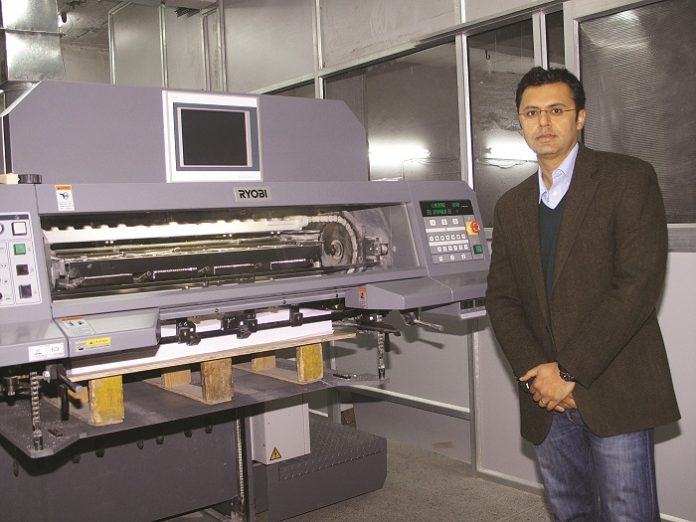
“In terms of commercial printing, anybody printing 4-color will be obsolete very soon. One should have a 4-color with a coater at least. The competition is so high, machines of 1980s or 1990s vintage cannot run the show any more. Finally, you should have prepress, press and postpress under the same roof to be more efficient – this will help you to gain on time, quality, cost, logistics and job secrecy,” says Abhishek Singh, director, Samrat Offset.
Samrat Offset recently installed a Ryobi 924D 4 plus coater press at its plant in Okhla, New Delhi. Now located in Okhla, New Delhi, the company at one time published Samrat Press, a newspaper in old Delhi. “We moved to Okhla in 1985 and till 1997 printed government material on single and double color Dominant presses,” says Abhishek Singh. The company installed its first 4-color press, a used Dominant, in 1997. As print volumes increased, Samrat bought a used 4-color Planeta in 2003 and added single and 2-color presses from Miller and Heidelberg. “In 2006, we got a contract from a large international organization that required high volume and stringent quality and so we bought our first brand new press – a Heidelberg CD102,” says Singh. Samrat subsequently added a new Heidelberg CD74 4-color with in-line coating.
Ryobi 924D 4 plus coater
At the 10,000 square-foot plant in Okhla, the recently installed Ryobi is the new excitement. “We chose the Ryobi 924D 4 plus coater press because we found in terms of plates, power and space, there is considerable saving. And the most significant advantage is the compact size of the press. We were almost out of room here to add another press. The compact size of the Ryobi allowed us to fit in a multicolor press with a coater in the limited space we had,” says Singh.
The Ryobi 924D 4 plus coater prints a maximum paper size of 920 x 640 millimetres with a maximum printing area of 900 x 615 millimetres, enabling the printing of A1-size posters as well as 8-up printing of both A4 size and letter-size products. It also prints on paper from a thin 0.04 millimetres up to 0.6 millimetres thick, enabling the flexible handling of a wide range of jobs. Aqueous or UV varnish coatings are applied by the machine’s retractable coating unit. In addition to adding value such as surface protection, or a glossy finish, this system also shortens drying time for a faster delivery. A built-in UV curing unit is used for high-gloss coating and other applications requiring even higher drying performance.
Strengthening in-house setup
Samrat Offset is now a fully equipped print business with prepress, press and postpress departments under the same roof. “The fast speed of our Heidelberg CD102 soon made us realize that without an in-house postpress setup, we would not be able to take full advantage of the new press. So we set up our own postpress section to take care of folding, glueing and binding,” says Singh. A Stahl folder, a Mechanotechnica saddle stitcher, Wellbound’s perfect binder and a Polygraph 3-knife trimmer make up the core of the postpress section. “In 2010, we made another round of investment where we bought a Heidelberg CD74 4-color with inline coater. We also bought a Heidelberg Suprasetter CtP and a Aster sewing machine – the investment strengthens our prepress, press and postpress.” The prepress section uses a pair of Epson printers for proofing. In addition, Samrat also has a Konica Minolta press for short-run printing. Apart from these, Samrat has Param’s MIS software in place for quick estimation, tracking and reporting of print projects.
Old machines are obsolete
Speaking about the industry, Singh says, “That commercial printing is going down is a fact. To keep going, you should have in-line coating, UV, foiling, and case-making facilities to be capable of delivering different types of finishes and customization to products. Today customers are looking at the best possible price and the quickest turnaround time with no compromise to quality – you need to have high service level expertise to survive.”
















